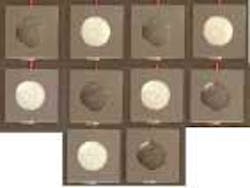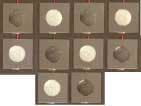Frustration gets results
Light traveling inside glass reflects at certain angles off the glass/air interface back into the glass with no loss, a phenomenon called total internal reflection (TIR). Placing a substance against the outside of the glass, however, can frustrate this process and cause the light to be transmitted through the glass surface and into the substance. This effect forms the basis of a type of display being developed by researchers at the University of British Columbia (UBC; Vancouver, BC, Canada).
The technique has antecedents, according to Robin Coope, one of the researchers. For example, a successful demonstration of actively controlled reflection was done by Jacob Tellerman of the Kollsman Instrument Company (Elmhurst, NY), says Coope. Tellerman received a patent in the early 1970s for an aircraft readout using rubber-tipped metal pins in contact with frosted glass. The metal would change length in response to magnetic fields and the rubber would go into and out of contact with the glass. But, though the technique achieved variable reflectance, it was not based on TIR, notes Coope.
To controllably switch TIR on and off, the UBC researchers start with a retroreflective polymeric sheet containing a large array of microprism corner cubes, which reflect most of the light hitting them (imperfect construction and other effects prevent perfect reflection). If a soft material with the proper properties is pressed against the back of the retroreflective sheet, the material contacts the microprisms, filling in the voids and letting the light pass through.
Finding the right soft material was not easy, but the researchers settled on a polydimethylsiloxane gel, which they treated with ozone to crosslink and harden the surface while leaving the underlying material compliant. Carbon black was added to the gel to absorb light. To switch the reflectivity off and on, pneumatic pressure was applied behind the gel membrane to force it against the sheet and switch off TIR; lowering the pneumatic pressure allowed separation and the reemergence of TIR (see figure). Even after 10,000 cycles, the gel returned to its original position. Switching time was about 0.25 s, with reflectivity changing between 75% and 25%.
But the UBC researchers believe this arrangement is unwieldy for many applications, and therefore are pursuing another approach. "We have investigated the use of electrophoresis to control the position of absorptive pigment particles, and this approach has demonstrated some very promising results, including the ability to achieve a full-color reflective display with up to a fourfold improvement in reflectance over current displays," explains Michele Mossman, a member of the group.
Such an approach may sound superficially similar to that of E-Ink (Cambridge, MA), a company that has commercially introduced electrophoretic displays with great success. But the E-Ink displays don't depend on switching TIR to achieve reflectivity or color changes; instead, they directly rely on the movement of colored or black and white particles within tiny, fluid-filled capsules to change the appearance of the display. Because TIR is such a strong effect, switching it on and off as in the UCB devices can potentially result in large changes in display contrast from particle movements that are very small.
REFERENCE
- R. J. N. Coope et al., Applied Optics (Sept. 1, 2002).

